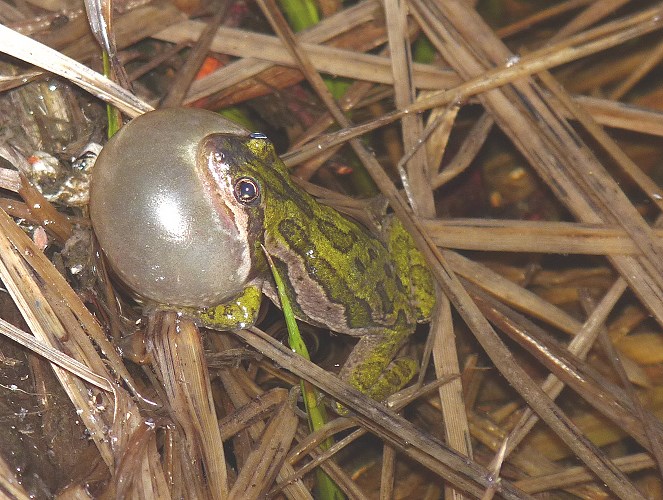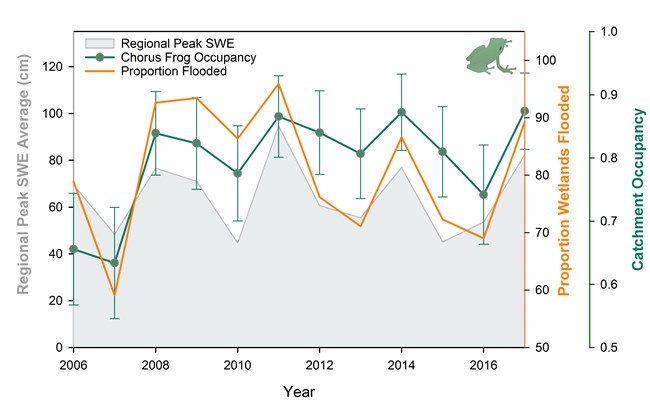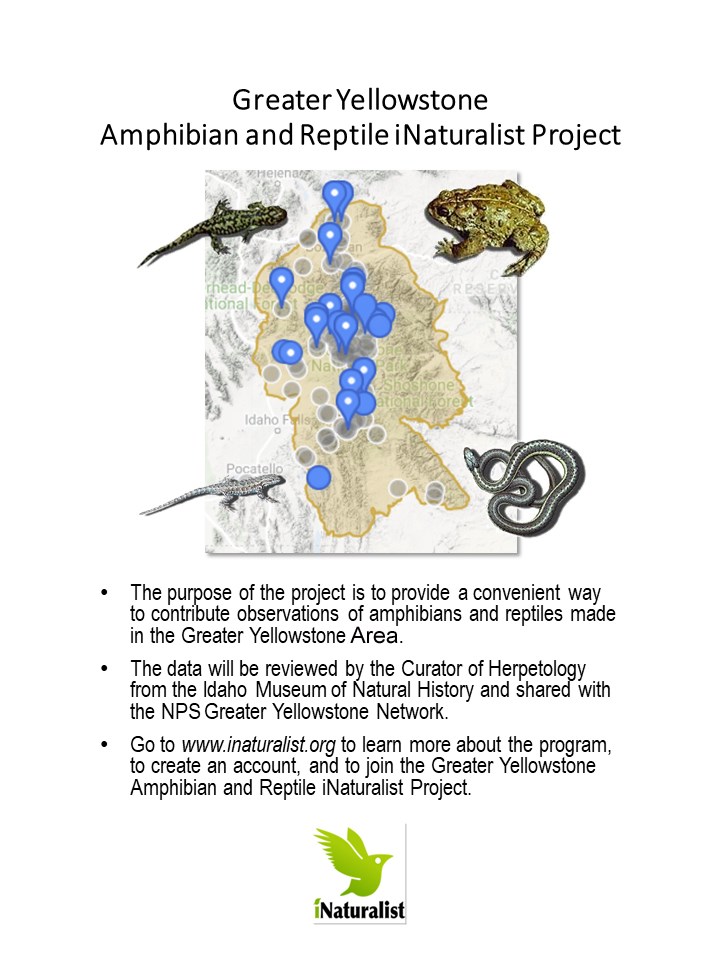Part of a series of articles titled Yellowstone Science - Volume 27 Issue 1: Vital Signs - Monitoring Yellowstone's Ecosystem Health.
Article
SHORT: Taking the Pulse of Wetlands

Photo - ©S. Corn
Taking the Pulse of Wetlands: What Are We Learning From the Amphibian Vital Sign?
by Andrew M. Ray, Debra A. Patla, & Charles R. Peterson
The air is thrumming with trills as our field crew in-training scans with binoculars, searching for a tiny head hidden in the roadside marsh. A voice from a car window calls out, “Do you see a bear?” “No, frogs!” we joyfully exclaim. But the baffled tourists depart before we can explain.
Why indeed care about tiny frogs, with so many spectacular and elsewhere-rare animals inhabiting Yellowstone National Park (YNP)?
Amphibians were selected as one of 12 vital signs for the Greater Yellowstone Network in 2005 (“Understanding Dynamic Ecosystems: The Pursuit of the Greater Yellowstone Network,” this issue). In light of global amphibian declines, there were urgent concerns about greater Yellowstone’s amphibian populations. Are native amphibians declining in Yellowstone and Grand Teton national parks; and if so, what are the causes? Furthermore, could amphibians inform us about changing conditions in wetlands, one of the most vital resources of the greater Yellowstone region?
Determining how to monitor these small animals across the large landscape was a challenge that engaged scientists from multiple organizations. Since 2006, we have followed a detailed protocol to annually monitor four native amphibian species at about 300 wetland sites in 30 watershed units (catchments) distributed across Yellowstone and Grand Teton national parks. Through our monitoring we have determined the western tiger salamander, boreal chorus frog, and Columbia spotted frog are widespread. Western toads are less widespread and thought to be less common than they were historically (Koch and Peterson 1995).
This program, now in its 14th year, covers a larger geographic area and more years than any other amphibian monitoring effort in the region. The rich data set garnered from extensive field work is yielding important insights about relative abundance, geographical distribution, and trends of the four most widespread amphibian species (Hossack et al. 2015, Ray et al. 2016). We are learning how amphibians indicate the importance of specific aspects of wetlands such as beavers, introduced fish, water depth, and spatial patterns (e.g., clustered or isolated water bodies). Analysis of the data is ongoing and we expect expanded understanding in the coming years.


The boreal chorus frog (photo) has emerged as an outstanding indicator of wetland conditions with respect to climate. More so than YNP’s other amphibian species, chorus frogs reproduce in very shallow, seasonal wetlands that are most subject to annual weather-mediated changes. Such wetlands are dynamic and variously abundant or scarcer according to each year’s weather. Across all the catchments, we have found a strong, positive relationship between chorus frog breeding occurrence, snowpack moisture (peak snow water equivalent; SWE), and the availability of wetlands (figure 1). Conversely, lower SWE corresponded to fewer wetlands available for breeding and, therefore, a reduction in chorus frog breeding.
If wetlands are of interest, why not just measure wetlands rather than frogs? It is because wetlands, depending on their permanency or resistance to drying, are made up of unique mixes of plants and animals (Ryan et al. 2014). Shallow, seasonal wetlands filled by melting snow are the first to dry in years with reduced snowpacks. These wetlands typically contain rapidly developing species like fairy shrimp, midges, and boreal chorus frogs. During years with low snowpacks when shallow wetlands dry early, there are fewer wetland sites available for breeding boreal chorus frogs. Conversely, the number of breeding sites increases sharply in abundantly wet years, such as 2011, 2014, and 2017. Through years of monitoring, this relationship between boreal chorus frogs and snowpacks has become obvious (figure 1; Ray et al. 2016). The establishment of warmer, drier weather patterns would have consequences for snowpacks, wetlands, and boreal chorus frogs, profoundly changing YNP’s spring and early summer soundscape. While the ecological effects of changes in amphibian populations are difficult to fully anticipate, we know amphibians are just one of many species dependent on these seasonal habitats (Ryan et al. 2014). In wetland food webs, amphibians are both prey and predators, and they occupy a unique niche as the only vertebrate with an aquatic larval (e.g., tadpole) stage and terrestrial adults. Garter snakes and other predators may be so strongly linked to amphibians that their presence in wetlands is entirely dependent on them (Matthews et al. 2002). In Yellowstone and Grand Teton national parks, the boreal chorus frog is our “spokesfrog” for seasonal wetlands and their vibrant biological diversity.
Will people of the future have the opportunity to enjoy frogs singing their role in the great animal orchestra of YNP? We plan to continue documenting how amphibians are faring, to help us better understand and predict the effects of changing climatic and wetland conditions. Your encounters with amphibians can help the monitoring effort: please see the iNaturalist box to learn how to share your observations. And remember, amphibians are sensitive species. Please treat them with respect and do not harass or pick up amphibians while you are naturalizing.
Literature Cited
Hossack, B.R., W.R. Gould, D.A. Patla, E. Muths, R. Daley, K. Legg, and P. S. Corn. 2015. Trends in Rocky Mountain amphibians and the role of beaver as a keystone species. Biological Conservation 187:260-269.
Koch, E.D., and C.R. Peterson. 1995. Amphibians and reptiles of Yellowstone and Grand Teton National Parks. University of Utah Press, Salt Lake City, Utah, USA.
Matthews, K.R., R.A. Knapp, and K.L. Pope. 2002. Garter snake distributions in high-elevation aquatic ecosystems: is there a link with declining amphibian populations and nonnative trout introductions? Journal of Herpetology 36:16-22.
Ray, A., W. Gould, B. Hossack, A. Sepulveda, D. Thoma, D. Patla, R. Daley, and R. Al-Chokhachy. 2016. Influence of climate drivers on colonization and extinction dynamics of wetland-dependent species. Ecosphere 7(7):e01409.
Ryan, M.E., W.J. Palen, M.J. Adams, and R.M. Rochefort. 2014. Amphibians in the climate vise: loss and restoration of resilience of montane wetland ecosystems in the western US. Frontiers in Ecology and the Environment 12:232-240.
Andrew Ray* is an Ecologist with the National Park Service’s Greater Yellowstone Network. Andrew has a PhD from Idaho State University, MS from Northern Michigan University, and BS from Purdue University. He works on wetland and water quality monitoring projects in Grand Teton and Yellowstone national parks and Bighorn Canyon National Recreation Area.
Debra Patla* has been engaged with the design and implementation of the cooperative amphibian monitoring program in Yellowstone since its earliest days (2000). Her work with amphibians began in 1993 with MS research (Idaho State University) investigating the decline of a Columbia spotted frog population near Lake Lodge in Yellowstone, and other amphibian projects across the Greater Yellowstone Ecosystem. She is a Research Associate of the Northern Rockies Conservation Cooperative.
Charles Peterson* is a Professor of Zoology in the Department of Biological Sciences at Idaho State University. He has been studying the amphibians and reptiles of Yellowstone National Park since 1989 and helped develop the amphibian monitoring program.
*All authors contributed equally to this article.
Last updated: September 17, 2019
